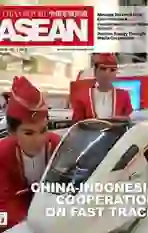Understanding China—ASEAN Strong Relations
2018-05-14
China-ASEAN Economic Ties
Since 2009, China has been ASEANs largest trading partner. ASEAN is Chinas third largest trading partner, third largest export market and second largest source of imports.
Two-way Investment
According to Chinese statistics, as of March 2018, two-way investment between China and ASEAN totaled US$196.64 billion.
ASEANs investment in China reached US$113.06 billion, accounting for 5.8 percent of foreign investment in China.
China is ASEANs fourth largest source of foreign capital and the largest source of foreign investment for Laos, Cambodia and Myanmar.
Chinese enterprises have accumulated a total investment of US$83.58 billion in ASEAN countries.
In 2017, the total import and export between China and ASEAN reached US$514.82 billion, which accounted for 12.5 percent of Chinas total foreign trade, up 13.8 percent over the previous year.
From January to March 2018, China-ASEAN bilateral trade volume reached US$133.64 billion, 12.8 percent of Chinas foreign trade and a year-on-year increase of 20.9 percent.
In 2017, ASEANs new investment in China was US$5.08 billion, a decline of 22.2 percent.
From January to March 2018, ASEANs new investment in China reached US$2.05 billion, a rise of 80.9 percent year-on-year.
has been Chinas largest source of foreign investment for four consecutive years.
ASEAN is one of the fastest-growing destinations for Chinas outward investment. China made an investment of US$9.47 billion in ASEAN in 2017, exceeding ASEANs investment in China again after 2015 and tilting towards a more balanced two-way investment.
From January to March 2018, Chinas new investment in ASEAN reached US$2.56 billion, a year-on-year increase of 34.5 percent.
By the end of 2017, China had established 27 large-scale economic and trade cooperation zones in eight ASEAN countries.
They attracted total investment of US$13.07 billion and produced total output value of US$47 billion. A total of 630 firms in these zones paid US$550 million in taxes to the host countries while providing 71,000 job opportunities for local people.
Chinas foreign aid to ASEAN was officially launched after Chinese Premier Li Keqiang announced for the first time that China would provide free assistance to ASEAN during the East Asia Summit in 2013. From 2013 to 2017, China provided ASEAN with a total of 300 million yuan (US$46 million) of free assistance in five phases, mainly used in disaster prevention, industrial park planning and construction and negotiations for upgrading the China-ASEAN Free Trade Area.
Project Contracting and Labor Services
From January to March 2018, the value of new contracts was US$4.7 billion with turnover of 7.49 billion.
ASEAN is Chinas most important overseas project contracting and labor services market. By the end of March 2018, the cumulative contract value and turnover of Chinas contracted engineering projects in ASEAN had reached
US$357.43 billion and 235.95 billion, respectively.
In terms of the cumulative contract value, Indonesia and Malaysia are Chinas third and eighth largest overseas contracting market.
By the end of March 2018, there were about 200,000 Chinese contract technicians and workers in ASEAN countries.
China-ASEAN Free Trade Area (CAFTA) is China's first free trade zone established outside the country.
The China-ASEAN Expo (CAEXPO) is co-sponsored by the Ministry of Commerce of China, ministries of commerce and industry of the 10 ASEAN countries as well as the ASEAN Secretariat and organized by the government of Chinas Guangxi Zhuang Autonomous Region. Since 2004, 14 editions of the annual event have been held in Nanning, capital of Guangxi.
China and ASEAN sign the China-ASEAN Framework Agreement on Comprehensive Economic Cooperation in Phnom Penh, Cambodia, and construction of the CAFTA officially kicks off.
Early harvest programs under the framework of the CAFTA launch.
China and ASEAN sign the Trade in Goods Agreement in Laos.
The tax reduction plan between China and six ASEAN member states (Singapore, Malaysia, Thailand, Indonesia, Brunei and the Philippines) is enacted.
China and ASEAN sign the Trade in Services Agreement in the Philippines. The agreement went into effect in July 2007.
China and ASEAN sign the Investment Agreement in Thailand.
The China-ASEAN Expo (CAEXPO) is co-sponsored by the Ministry of Commerce of China, ministries of commerce and industry of the 10 ASEAN countries as well as the ASEAN Secretariat and organized by the government of Chinas Guangxi Zhuang Autonomous Region. Since 2004, 14 editions of the annual event have been held in Nanning, capital of Guangxi.
On January 1, 2010, CAFTA was fully established. Chinas average duty rate of imports from ASEAN was reduced to 1.0 percent and over 90 percent of products from ASEAN were exempted from tariffs. Since 2015, ASEAN has given zero-tariff treatment to more than 90 percent of imports from China.
Proposed by China, negotiations for an upgraded CAFTA started during the AEM-MOFCOM Consultations held in August 2014. In November 2015, the two sides signed an outcome document titled Protocol to Amend the Framework Agreement on Comprehensive Economic Cooperation and Certain Agreements between ASEAN and China, covering fields such as trade in goods, trade in services, investment and economic and technological cooperation. The protocol entered into force on July 1, 2016.
One year after ASEAN announced the establishment of the ASEAN Economic Community, the regional bloc issues its MPAC 2025 as a guiding document for promoting regional connectivity.
Based on the MPAC 2025, China and ASEAN established cooperation mechanisms and launched a number of cooperative projects.
In September 2012, a Chinese committee under the China-ASEAN Committee on Connectivity Cooperation was established with participation from Chinas Ministry of Commerce, the National Development and Reform Commission, the Ministry of Foreign Affairs, the Ministry of Finance, the Ministry of Industry and Information Technology, the Ministry of Transport, the National Railway Administration and the governments of Guangxi and Yunnan. So far, the China-ASEAN Committee on Connectivity Cooperation has held three meetings. At the third meeting held in late July 2017, the two sides reviewed progress made since the second meeting, agreed to enhance synergy between Chinas Belt and Road Initiative and the MPAC 2025, and discussed priority areas and specific projects for future cooperation.
